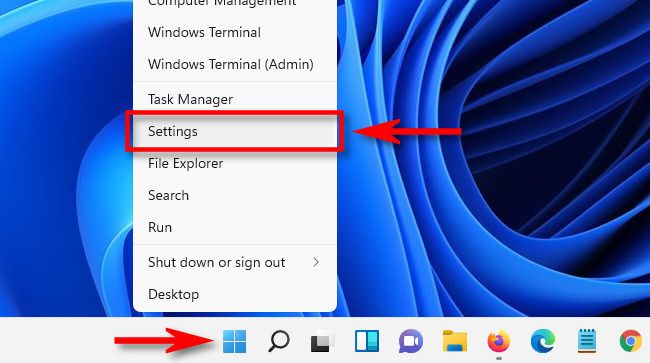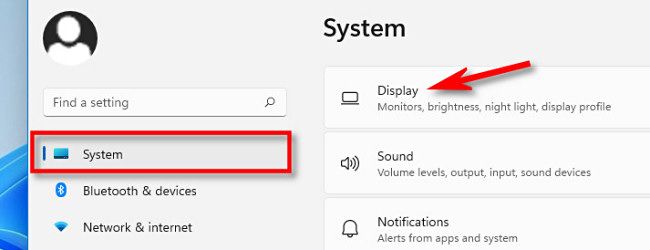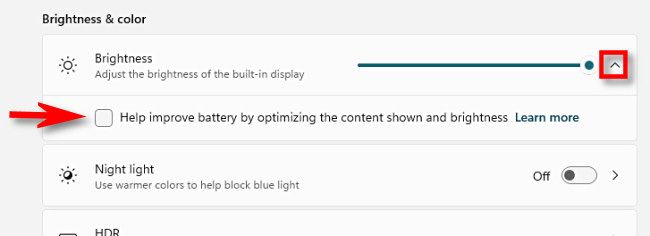You are here:
Home » Windows 10 » How To Disable Auto or Adaptive Screen Brightness In Windows 10
Last evening, I received the new ThinkPad laptop that I had ordered a couple of days ago through an eCommerce website. Since the ThinkPad ships with an earlier version of Windows 10, I upgraded the OS to the latest version of Windows 10 Pro, and the upgrade process went smoothly without any issues.
After upgrading to the latest version of Windows 10 and installing/updating all drivers, while browsing the web, I noticed that Windows 10 was automatically adjusting the screen brightness. Like most users, I prefer manually setting screen brightness and don’t want the operating system to automatically adjust screen brightness with the help of ambient light sensors.
For the uninitiated, when the adaptive screen brightness feature is running, Windows 10 calculates the ambient light using the built-in sensors of your PC and automatically adjusts the screen brightness accordingly.
If your Windows 10 is automatically adjusting the screen brightness, it’s most likely because a feature called adaptive brightness is turned on. And if you’re sure that the adaptive brightness or auto-brightness is disabled on your PC, then it could be because your PC using Intel HD graphics and the Intel power saver technology is trying to save some power by automatically decreasing the backlight intensity.
In this guide, we will see how to disable the auto-brightness or adaptive brightness in Windows 10. Use the directions in Method 3 to configure the Intel HD Graphics Control Panel and instructions in Method 4 to turn off the display power-saving technology in AMD, which decreases backlight intensity to extend the battery life.
Method 1 of 5
Disable automatic brightness in Windows 10 via Settings
NOTE: Available in Windows 10 build 21354 and later only. Also, the option shows up only if your PC supports the Content adaptive brightness control (CABC).
Step 1: Go to Windows 10 Settings app > System > Display page.
Step 2: Turn off the option labeled Automatically adjust contrast based on the displayed content to help improve battery.

Method 2 of 5
Disable adaptive or auto brightness via Control Panel
Step 1: Right-click on the battery icon in the system tray and click Power Options to open the same.

Step 2: On the left pane, click Choose when to turn off the display option to open the Edit Plan Settings window.

Step 3: Here, click Change advanced power settings to open the Power Options dialog.

Step 4: Extend Display, extend Enable adaptive brightness, and then select Off option for both On battery and Plugged in.

Click the Apply button.
Note that you have just disabled adaptive brightness only for the current power plan. So, if you often switch between the power plan, you need to repeat the same for all power plans. For instance, if you just disabled adaptive brightness for a Balanced power plan, you will need to do the same for the Power saver plan as well if you don’t want Windows 10 to automatically adjust the brightness while using the Power saver plan.
Method 3 of 5
Disable automatic brightness via the Intel Graphics Command Center app
Step 1: Launch the Intel Graphics Command Center app using the taskbar/Start search. If not installed, you can get it from the Windows 10 Store.
Step 2: Once the app is running, in the left pane, click on System.
Step 3: Now, on the right side, click Power.
Step 4: In the On battery section, turn off the Display Power Savings option. That’s it!

Method 4 of 5
Disable auto-brightness via Intel HD Graphics Control Panel
If you have AMD graphics, follow the directions in Method 3.
I am no expert and I might be completely wrong, but it looks like the Intel power saver technology was the reason why I was feeling like the display brightness was automatically adjusting even after turning off adaptive brightness.
Use this method only if you have a feeling that the screen brightness is automatically adjusting even after turning off auto-brightness using the instructions mentioned above. Obviously, this is only for PCs that ship with Intel onboard graphics.
There might be a similar feature/option in graphics drivers from other manufacturers as well. Have a look at the properties of the graphics drivers before contacting Microsoft support.
Step 1: Right-click on the desktop and click Graphics Properties.

NOTE: If the Graphics Properties option is not available in the desktop context menu, open Control Panel, change View by to Small icons and then click Intel HD Graphics.

Step 2: Once Intel HD Graphics Control Panel is launched, click Power.

Step 3: On the left pane, click On Battery.
Step 4: Finally, click Disable option for Display Power Saving Technology and then click Apply button.

If the issue is fixed, remember that Intel graphics Control Panel might be reset to default settings when a newer version of the driver is installed, and you might need to disable the feature again by following the directions mentioned above.
Method 5 of 5
Disable AMD Vary-Bright
Step 1: Right-click on the desktop and then click on the AMD Radeon Settings option.
Step 2: Expand the Power tab and then click on PowerPlay. Here, disable or turn off the Enable Vari-Bright option.
Your automatic brightness issue should now be solved. Good luck!
If you have a dedicated graphics card, please check out its settings as well. Your automatic brightness issue should now be solved. Good luck!
Do let us know if you were able to fix the issue using one of these methods.
В этой статье:
-
Настройка яркости дисплея
-
Ночной свет
-
Управление цветным профилем
-
Использование HDR
Настройка яркости дисплея
Управление яркостью дисплея может значительно улучшить просмотр и сэкономить время работы батареи. Вы можете настроить яркость вручную или позволить компьютеру обрабатывать ее автоматически в зависимости от условий освещения или содержимого.
Важно: Ползунок Яркость может не отображаться на устройствах с внешним монитором. Чтобы изменить яркость внешнего монитора, используйте кнопки на нем.
Чтобы настроить яркость экрана, щелкните значок Сеть в правой части панели задач, а затем переместите ползунок Яркость , чтобы настроить яркость.
Кроме того, можно настроить яркость дисплея в разделе Параметры > системный > дисплей.
Важно: Ползунок Яркость может не отображаться на настольных компьютерах с внешним монитором. Чтобы изменить яркость внешнего монитора, используйте кнопки на нем.
На некоторых компьютерах Windows может автоматически регулировать яркость экрана в зависимости от текущих условий освещения. Чтобы узнать, поддерживает ли это ваш компьютер, выберите Параметры > системный > дисплей. Выберите Яркость, найдите поле Изменение яркости автоматически при изменении освещения проверка а затем выберите его, чтобы использовать эту функцию. Благодаря этой автоматической настройке текст на экране будет хорошо виден независимо от окружающих условий. Даже если вы используете его, вы все равно можете переместить ползунок Яркость, чтобы точно настроить уровень яркости для встроенного дисплея.
Примечание: На дисплеях HDR Windows оптимизирует автоматическую корректировку яркости в соответствии с тем, как воспринимает изменение яркости человеческий глаз. В результате регулировка яркости может занять больше времени на дисплеях HDR при изменении условий освещения.
Некоторые Windows 11 пк могут автоматически настраивать яркость и контрастность экрана в зависимости от содержимого, отображаемого на встроенном экране. Например, если вы смотрите видео с темной сценой, за которой следует более яркая сцена (например, с ярким солнечным днем), яркость и контрастность могут измениться. Это нормально.
Адаптивное управление яркостью содержимого обеспечивает идеальный уровень яркости и контрастности, одновременно экономя питание и обеспечивая более длительное время работы батареи. Если эти внезапные изменения яркости отвлекают вас или если вы работаете в приложениях для фото и видео, где точность цвета важна для вас, эти параметры можно настроить в соответствии с вашими потребностями между обеспечением соответствующей яркости и контрастности и экономией заряда батареи.
-
Нажмите кнопку Пуск и введите параметры. Выберите Параметры > Системный > Дисплей .
-
В разделе Параметры отображения выберите Яркость , а затем при необходимости задайте раскрывающийся список Изменить яркость на основе содержимого:
-
От: Адаптивное управление яркостью будет отключено, а яркость и контрастность экрана не будут регулироваться. Это может привести к более короткому сроку работы батареи.
-
Всегда:Адаптивное управление яркостью всегда будет работать независимо от того, подключено ли устройство к сети или от батареи.
-
Только от батареи: Адаптивное управление яркостью будет активировано только в том случае, если устройство работает от аккумулятора.
-
Ночной свет
Дисплей излучает синий свет, похожий на дневной. Однако ночью этот свет может мешать вам спать. Чтобы лучше засыпать, включите ночной свет для дисплея. В результате свет дисплея смягчится и не будет утомлять глаза.
Примечание: Ночной индикатор недоступен, если на устройстве используются определенные драйверы, например DisplayLink или Basic Display.
Щелкните значок Сеть в правой части панели задач. затем найдите Ночной свет в разделе Быстрые параметры и выберите его, чтобы включить или отключить его.
Кроме того, можно переключить параметр Ночной свет в разделе Параметры > системный > дисплей.
-
Нажмите кнопку Пуск , а затем введите параметры в поле поиска. Выберите Параметры > Система > Отображение > ночного света.
-
Переместите ползунок прочности, чтобы отрегулировать интенсивность уменьшения синего света.
-
Нажмите кнопку Пуск , а затем введите параметры в поле поиска. Выберите Параметры > Система > Отображение > ночного света.
-
Включите параметр Расписание ночного света. Затем выберите От заката до рассвета или Установить время и задайте время включения и отключения ночного света.
Управление цветным профилем
Параметры управления цветом Windows позволяют пользователям добавлять или удалять цветовые профили, задавать цветовые профили по умолчанию для подключенных дисплеев, а также получать доступ к калибровке дисплея и включать автоматическое управление цветом.
Творческие профессионалы и энтузиасты заботятся о полностью откалиброванных, точных цветах, потому что это помогает обеспечить согласованность цветов от начала до конца своих проектов. Автоматическое управление цветами в Windows обеспечивает управление цветом на уровне системы, чтобы цвета в приложениях Windows отображались точно и согласованно на поддерживаемых дисплеях независимо от того, управляются ли они цветом.
Автоматическое управление цветом также помогает новым и обновленным приложениям отображать больше цветов с большей точностью. Это обеспечивает дополнительную детализацию и меньшее число цветовых артефактов (например, в градиентах, тени и более темных сценах или рисунках). Благодаря автоматическому управлению цветом приложения могут использовать миллиарды цветов с точностью от 10 до 16 бит. Даже на дисплеях, поддерживающих только 8-разрядный цвет, автоматическое управление цветом помогает улучшить качество цвета с помощью различных методов, таких как дизеринг.
Включение автоматического управления цветом
-
Нажмите кнопку Пуск , а затем выберите Параметры > Системный > Дисплей > Профиль цвета.
-
Выберите дисплей в верхней части экрана, а затем проверка для следующего параметра: Автоматическое управление цветом для приложений.
-
Выберите Автоматически управлять цветом для приложений, чтобы включить его.
-
Перейдите в раздел Параметры > Системный > Дисплей > Профиль цвета.
-
На странице Параметры управления цветом выберите дисплей, для которого вы хотите управлять цветными профилями.
-
Добавьте новый цветной профиль, щелкнув Добавить профиль и найдите цветной профиль.
-
Перейдите в раздел Параметры > Системный > Дисплей > Профиль цвета.
-
На странице Параметры управления цветом выберите дисплей, для которого вы хотите управлять цветными профилями.
-
Разверните цветной профиль, который нужно удалить, и нажмите кнопку Удалить в нижней части экрана.
-
Перейдите в раздел Параметры > Системный > Дисплей > Профиль цвета.
-
На странице Параметры управления цветом выберите дисплей, для которого вы хотите управлять цветными профилями.
-
Задайте один из цветовых профилей по умолчанию, нажав кнопку Задать профиль.
-
Перейдите в раздел Параметры > Системный > Дисплей > Профиль цвета.
-
Выберите Calibrate display (Калибровка дисплея ) и следуйте инструкциям по калибровке дисплея. При этом будет создан новый цветовой профиль для дисплея, на котором расположен инструмент калибровки.
Использование HDR
Содержимое HDR в Windows обеспечивает лучшую яркость и цветовые возможности по сравнению с традиционным содержимым (иногда называемое стандартным динамическим диапазоном [SDR]). Традиционное содержимое обычно показывает детали в яркой части сцены или более темной части сцены, но не в обеих частях одновременно.
Дополнительные сведения о параметрах HDR в Windows см. в статье Что такое HDR в Windows?
Let’s face it. Dealing with auto-brightness on Windows 10 can be a bit annoying, especially when the screen brightness keeps changing without your consent. But don’t worry, turning it off is a piece of cake! All you have to do is dig into your system settings, and voilà! Your brightness will stay exactly where you want it. Now, let’s get down to business.
Turning off auto-brightness on Windows 10 means you’ll have full control over your screen’s brightness without any automatic adjustments. Follow these steps, and you’ll be the master of your screen’s destiny.
Step 1: Open the Settings App
Click on the Start Menu and select the Settings icon.
The Settings app is like the control hub for your computer. You can find it by clicking on the little gear icon in the Start Menu.
Step 2: Go to System
In the Settings window, click on «System.»
The System section is where you’ll find all the settings related to your computer’s display, sound, notifications, and power.
Step 3: Select Display
In the System menu, select «Display» from the list on the left.
The Display settings will allow you to control how your screen looks, including brightness, resolution, and orientation.
Step 4: Turn Off Change Brightness Automatically
Scroll down and find the option labeled «Change brightness automatically when lighting changes.» Toggle this option off.
By turning this off, you’re telling your computer to stop adjusting the brightness based on ambient lighting. Now, your screen brightness will stay constant.
Step 5: Adjust Brightness Manually
Use the slider above the automatic brightness setting to adjust your screen brightness to your preferred level.
This slider lets you set the brightness to a level that’s comfortable for your eyes, whether you’re working in a dim room or under bright lights.
After you follow these steps, your screen brightness should remain consistent, no matter what lighting conditions you’re in. It’s all about taking control!
Tips for Turning Off Auto Brightness Windows 10
- Check for Updates: Sometimes, Windows updates can reset your settings, so make sure to double-check after each update.
- Battery Considerations: Turning off auto-brightness can drain your battery faster, especially on laptops.
- Night Light: Consider using Night Light mode if you want to reduce eye strain during evening hours.
- Graphics Drivers: Ensure your graphics drivers are up-to-date to avoid any display issues.
- Ambient Light Sensors: Some devices have hardware sensors that might still affect brightness. Consult your device manual if issues persist.
Frequently Asked Questions
Why does my screen keep changing brightness?
Your screen changes brightness due to the auto-brightness feature, which adjusts based on ambient lighting conditions to save power and reduce eye strain.
Can I turn off auto-brightness on all monitors?
Most built-in laptop monitors support this feature, but external monitors may not have the same settings.
Will turning off auto-brightness affect my battery life?
Yes, turning off auto-brightness can lead to a decrease in battery life because the screen may stay brighter than necessary.
What if I can’t find the auto-brightness setting?
Ensure your device supports this feature and that all drivers are updated. If you still can’t find it, consult your device’s user manual or support website.
Can I set different brightness levels for different power modes?
Yes, you can set different brightness levels for battery and plugged-in modes through the Power & Sleep settings in the System menu.
Summary
- Open the Settings App.
- Go to System.
- Select Display.
- Turn Off Change Brightness Automatically.
- Adjust Brightness Manually.
Conclusion
So, there you have it! Turning off auto-brightness on Windows 10 is a straightforward process that gives you full control over your screen brightness. By following these simple steps, you can ensure that your display stays at a consistent brightness level, which can be especially helpful when you’re working or watching something for extended periods.
Remember, technology should work for you, not the other way around. If you find that your screen brightness changes are more of a nuisance than a help, don’t hesitate to make these adjustments. And if you’re concerned about battery life, consider tweaking other settings to compensate for the constant brightness.
For further reading, you might want to explore more about power management settings and how they can affect your device’s performance. Feel free to drop any questions in the comments or check out our other articles for more tips and tricks on managing your Windows 10 experience.
Matt Jacobs has been working as an IT consultant for small businesses since receiving his Master’s degree in 2003. While he still does some consulting work, his primary focus now is on creating technology support content for SupportYourTech.com.
His work can be found on many websites and focuses on topics such as Microsoft Office, Apple devices, Android devices, Photoshop, and more.
Sign in to your How-To Geek account

Quick Links
-
Understanding Windows Automatic Brightness
-
How to Disable Adaptive Brightness in Windows 10 or 11
If you’re tired of your Windows 10 or 11 PC’s screen automatically getting brighter or dimmer, it’s easy to turn off. All it takes is a quick trip to Settings. Here’s how to do it.
Understanding Windows Automatic Brightness
Before we get started, it’s important to know that automatic (or adaptive) brightness only applies to Windows devices with built-in screens such as laptops, tablets, and all-in-one desktop PCs. If you use an external monitor, you probably won’t see controls for adaptive brightness in Settings.
Some Windows devices automatically adjust screen brightness based on ambient lighting conditions, and some don’t. If so, these changes are based on readings from a light sensor built into your device.
Also, some PCs allow automatic changes in brightness depending on what you’re viewing on your screen, which helps save battery life. Microsoft calls this feature «content adaptive brightness control,» or CABC. Depending on which of these features your Windows PC supports, you may see one or two check boxes to control these options in Settings, which we’ll cover below.
How to Disable Adaptive Brightness in Windows 10 or 11
When you’re ready to disable auto brightness, first open Windows Settings by pressing Windows+i. Or you can right-click the Start button and select «Settings» in the list.

When the Settings app opens, in Windows 10, click «System,» then select «Display» in the sidebar. In Windows 11, click «System» in the sidebar, then select «Display.»

Under the «Brightness and Color» section in Windows 10, look below the Brightness slider and uncheck the box beside «Automatically adjust contrast based on the displayed content to help improve battery» or «Change brightness automatically when lighting changes.» If you see both options, uncheck both.
In Windows 11, click small arrow beside the «Brightness» slider to expand a small menu, then uncheck «Help improve battery by optimizing the content shown and brightness.»
If you see «Change brightness automatically when lighting changes,» uncheck that as well.

After that, close Settings. From now on, your screen brightness will always stay how you set it under manual control. Happy computing!
Disable adaptive brightness in Settings or Control Panel
Updated on November 24, 2023
What to Know
- Windows 11: Go to Settings > System > Display > Brightness, then turn off battery optimization.
- Windows 10: Power Options > Change plan settings > Change advanced power settings > Display > turn off Enable adaptive brightness.
- If you can’t disable auto brightness, create a new Power Plan and adjust it as you wish.
This article explains how to turn off auto brightness (also known as adaptive brightness) in Windows. The instructions apply to Windows 11 and Windows 10.
How to Turn Off Auto Brightness on Windows 11
The auto-brightness options are different depending on your version of Windows. On Windows 11, you can use the Settings app to disable battery-saving features that affect screen brightness.
Not all Windows 11 devices support the options mentioned in these steps.
-
Open the Start menu and select Settings.
-
Select System, then choose Display.
-
Select Brightness.
-
Uncheck the box next to Help improve battery by optimizing the content shown and brightness.
-
Go back to System settings and select Power & battery.
-
Select Battery saver.
-
Turn Off the toggle switch next to Lower screen brightness when using battery saver.
How to Turn Off Auto Brightness on Windows 10
In some versions of Windows 10, you can disable advanced power settings through Control Panel.
-
Open Control Panel. One way is to search for it from the Start menu.
-
Select the heading called Hardware and Sound.
-
Choose Power Options.
-
Select Change plan settings to the right of the selected power plan.
-
Select Change advanced power settings and a small window will appear.
-
Scroll down to find Display, and select the plus sign next to it for more options.
-
Next to Enable adaptive brightness is a drop-down menu. Set it to Off, then press OK, to disable the auto-brightness feature.
How to Create a Power Plan in Windows
Not all Windows computers have the option to disable auto-brightness. In that scenario, you can create a new Power Plan and ensure your computer’s brightness settings stay consistent. This works in Windows 11 and Windows 10.
-
Go back to Power Options in Control Panel and select Create a power plan on the left-hand side of the window.
-
Select a plan. Your options include Balanced (recommended), Power saver, and High performance.
-
Name your custom power plan and then select Next.
-
Configure the plan to suit your needs. In this example, the laptop display is set to turn off after 5 minutes and go to sleep after 10 minutes of inaction.
-
Select Create, and your new custom plan will be made
FAQ
-
If you don’t see an option to turn this feature off from Power Options or it doesn’t seem to work, open the Intel graphics control panel you have on your device. Select Power and move the toggle to the off position next to Adaptive Brightness or uncheck the box next to Display Power-Saving Technology or Maximum Performance power plan.
-
If your Sony VAIO has a setting to adjust automatic brightness, turn this feature off from Power Options as described above. Then open the VAIO Control Center > select Display > and uncheck the box beside Adjust Brightness Settings Automatically.
Thanks for letting us know!
Get the Latest Tech News Delivered Every Day
Subscribe
